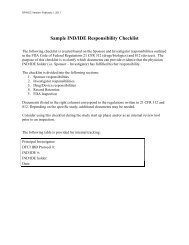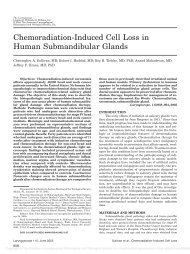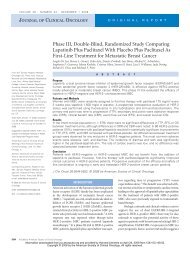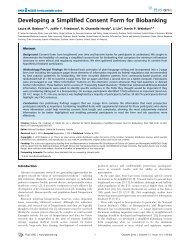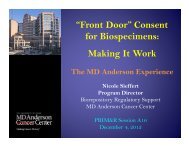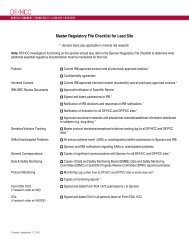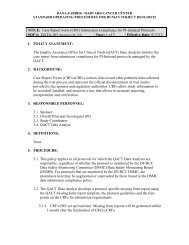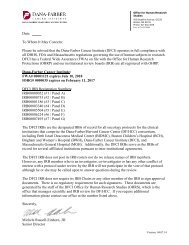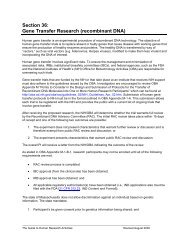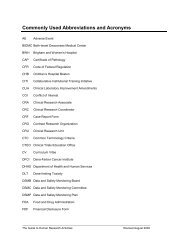Dr. Folkman's progeny - Dana-Farber/Harvard Cancer Center
Dr. Folkman's progeny - Dana-Farber/Harvard Cancer Center
Dr. Folkman's progeny - Dana-Farber/Harvard Cancer Center
Create successful ePaper yourself
Turn your PDF publications into a flip-book with our unique Google optimized e-Paper software.
<strong>Dr</strong>. Folkman’s <strong>progeny</strong>Research in a variety of initiatives, touching many fields,is showing extraordinary promiseBy Robert CookeFor a look into the future of angiogenesis research, read the handwritingon the wall in Judah Folkman’s small conference room.Listed in his scrawl, now protected with Plexiglas (and picturedabove), are problems not yet solved in 2007 and things he hopedmight get done in 2008.Unfortunately, the renowned surgeon and cancer researcher’spersonal role in solving those problems came to a sudden end inJanuary, when he died en route to speak at a scientific conference.But part of Folkman’s genius was to mentor and inspire generationsof researchers who are carrying his pioneering work forward—many of them in the Vascular Biology Program he founded atChildren’s Hospital Boston.“The program is strong and vital because <strong>Dr</strong>. Folkman createdit that way,” says Marsha Moses, PhD, a long-time memberof Folkman’s team who is interim co-director of the program withDonald Ingber, MD, PhD. “And we plan to solidify that.”There’s great hope that the questions on the wall, and manymore not yet thought of, will someday be answered. Below areGiannoula Klement, MDVascular Biology Programsome of the most promising projects—and the people Folkmaninspired to pursue them.Treating the biomarkerOne of Folkman’s biggest dreams was to treat cancer like achronic disease, using agents that block blood-vessel growth,or angiogenesis, to “starve” the cancer and keep it dormant.Moses and others have begun to realize that vision, discovering“biomarkers” that give early warning that a tumor is starting toexpand or recur. Guided by biomarkers alone, doctors could beginimmediate treatment with angiogenesis inhibitors.Giannoula Klement, MD, a pediatric hematologist/oncologistfrom <strong>Dana</strong>-<strong>Farber</strong> <strong>Cancer</strong> Institute who does research inFolkman’s lab, has discovered that blood platelets harbor some ofthe best biomarkers available.“Platelets are the first responders to injury, inflammation or tumorgrowth,” Klement says. “They continuously sequester, store andtransport proteins that regulate blood vessel growth, and can deliverthese regulators to an injury or tumor site in very high concentrations.”In mice seeded with human tumors, Klement has shown thatangiogenesis regulators are indeed highly concentrated in platelets,and that elevated levels can be detected before they showup in plasma, and before the cancer becomes clinically evident.“Almost as soon as an angiogenic tumor is present, the plateletangiogenesis protein profile changes to reflect what the tumorsmay be secreting,” she says.Klement believes platelet profiling could provide a highlyaccurate way of staging and monitoring cancers over time, andhopes to test this idea in cancer patients. In a recent paper, shesuggests that new cancer therapies might someday “instruct”platelets to selectively release predominantly anti-angiogenicfactors and inhibit tumor growth.“<strong>Dr</strong>. Folkman was very excited about this,” she says. “Hewas keen on getting it all confirmed in humans.”Controlling metastasisMetastasis—the migration of cancer cells to other parts of thebody—is the most dangerous phenomenon in cancer, generally20 Vector | Spring 2008 | childrenshospital.org/vector
levels. While Hansen collects umbilical cord blood samples frommothers, Barnés is working to develop a blood test to establisha minimum necessary 2ME2 level. “If we can find a threshold,maybe we could give preterm babies replacement therapy,”Barnés says.In early February, Barnés won an award from the MassachusettsTechnology Transfer <strong>Center</strong> to support her 2ME2 work,which may also help doctors understand and treat preeclampsia,a life-threatening rise in blood pressure in late pregnancy. Sadly,Folkman died shortly before the award was made final. But the proposalwon on its own merits, with Barnés as principal investigator.TURNING HYDROCEPHALUS ON ITS HEADIn 2006, Folkman attended another Grand Rounds lecture, byneurosurgeon Joseph Madsen, MD. The topic was hydrocephalus,or water on the brain, which can lead to severe brain damage.For decades, hydrocephalus treatment has involved installinga shunt to drain the excess fluid into the abdomen. But there areoften problems, including the need to replace the shunts. Madsendiscussed how hydrocephalus was being explored in terms ofphysics, with the idea that pulses in blood pressure might beinvolved.Folkman approached Madsen afterward, suggesting thathydrocephalus might be an angiogenic problem: The excess fluidmight be coming from abnormal, leaky blood vessels, a problemknown to occur in some eye disorders. If so, a drug treatmentmight be possible. “He laid out two years’ worth of research inthat one encounter,” Madsen recalls.Within 10 days, Madsen’s team was sending cerebrospinalfluid samples to Folkman’s lab, which tested them for vascularendothelial growth factor (VEGF), an angiogenesis stimulator thatJoseph Madsen, MD, NeurosurgeryCarmen BarnÉs, PhD, Vascular Biology Program (left),and Anne Hansen, MD, Newborn Medicinecan also make blood vessels leaky. “He faxed me from Japan,”Madsen says, “saying ‘this is extremely important.’”Many patients’ fluid samples had markedly elevated VEGFlevels, suggesting that leaky blood vessels might indeed contributeto hydrocephalus, and that an anti-angiogenic drug likeAvastin, which specifically targets VEGF, might relieve the disorder.Madsen’s Neurodynamics Laboratory is now exploring this“leakage” hypothesis.Angiogenesis: an organizing principle in medicine?Folkman’s most recent papers lay out the case for angiogenesisas an organizing principle in biology, medicine and drug discovery.Although his propensity to make creative connections wasrepeatedly criticized during his lifetime, he often turned out tobe correct. As early as 1971, he proposed a connection betweenangiogenesis and certain eye diseases; today, hundreds of thousandsof patients with the blinding disease macular degenerationare benefiting from the angiogenesis inhibitors Macugen andLucentis, which are slowing or even reversing their vision loss.Folkman loved to tell the following anecdote. A few yearsago at a major cancer conference, he was in the audience whensuccessful use of Avastin, the first anti-angiogenic drug to becommercialized for treating cancer, was announced to cheeringand loud applause.He overheard a nearby researcher tell a colleague, “If onlyFolkman were alive to see this!”He was—and he enjoyed it immensely.more at childrenshospital.org/vectorView archival photos and video interviews with Folkman,and learn more about the Vascular Biology Program.22 Vector | Spring 2008 | childrenshospital.org/vector



